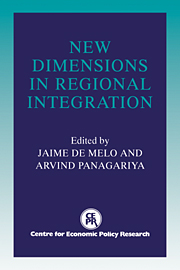Book contents
- Frontmatter
- Contents
- List of figures
- List of tables
- Preface
- Foreword
- Acknowledgements
- List of conference participants
- PART ONE SYSTEMIC ISSUES
- PART TWO COUNTRY ISSUES
- 6 The new regionalism: a country perspective
- Discussion
- 7 The European Community: a case of successful integration?
- Discussion
- 8 Regional integration in Sub-Saharan Africa: past experience and future prospects
- Discussion
- 9 Latin America's integration and the multilateral trading system
- Discussion
- 10 Regional integration in Eastern Europe: prospects for integration within the region and with the European Community
- Discussion
- 11 Regional trade arrangements in North America: CUSTA and NAFTA
- Discussion
- 12 Trading blocs and East Asia
- Discussion
- 13 Prospects for regional integration in the Middle East
- Discussion
- Round Table Discussion
- Index
13 - Prospects for regional integration in the Middle East
Published online by Cambridge University Press: 04 May 2010
- Frontmatter
- Contents
- List of figures
- List of tables
- Preface
- Foreword
- Acknowledgements
- List of conference participants
- PART ONE SYSTEMIC ISSUES
- PART TWO COUNTRY ISSUES
- 6 The new regionalism: a country perspective
- Discussion
- 7 The European Community: a case of successful integration?
- Discussion
- 8 Regional integration in Sub-Saharan Africa: past experience and future prospects
- Discussion
- 9 Latin America's integration and the multilateral trading system
- Discussion
- 10 Regional integration in Eastern Europe: prospects for integration within the region and with the European Community
- Discussion
- 11 Regional trade arrangements in North America: CUSTA and NAFTA
- Discussion
- 12 Trading blocs and East Asia
- Discussion
- 13 Prospects for regional integration in the Middle East
- Discussion
- Round Table Discussion
- Index
Summary
The Middle East is the home of three great religions and a host of historic conflicts: between Israel and the Arab countries; between Iran and Iraq; between Iraq and members of the Gulf War coalition: in Lebanon; between religious fundamentalists and secularists; and sub rosa between the rich ‘have’ states of the Gulf and the ‘have nots’ in most of the rest of the region. The potential for economic integration in the region is inextricably tied up with the resolution of these political conflicts.
Definitions of the Middle East range from the Balkans and Turkey in the north, to Mauritania in the west, Sudan in the south, and Pakistan in the east. Alternative definitions reflect differing emphases on some of the characteristics of countries in the area – Arab, Islamic, and geographic. To focus discussion, I will follow the International Monetary Fund (IMF) in defining the region as consisting of the fifteen countries listed in Table 13.1: the Gulf states and Yemen, Israel and its neighbours, and Libya. For convenience, I shall refer to the Gulf states and Yemen as the Southern ME, and the remaining states as the Northern ME. The Occupied Territories of the West Bank and Gaza are part of the region but are not listed in Table 13.1: their population is about 1.7 million, and per capita income is about $1200.
The most significant definitional choices are whether to include Turkey, which has long-standing historic ties with the region, and Iran.
- Type
- Chapter
- Information
- New Dimensions in Regional Integration , pp. 423 - 448Publisher: Cambridge University PressPrint publication year: 1993
- 6
- Cited by

